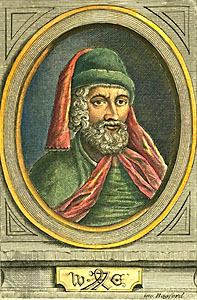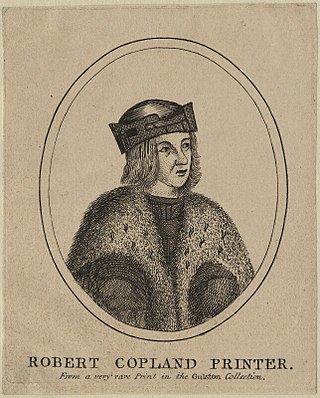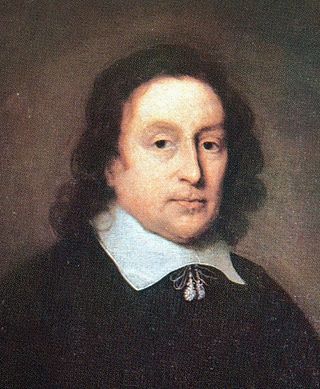Related Research Articles

William Caxton was an English merchant, diplomat and writer. He is thought to be the first person to introduce a printing press into England in 1476, and as a printer to be the first English retailer of printed books.
This article contains information about the literary events and publications of 1521.

Wynkyn de Worde was a printer and publisher in London known for his work with William Caxton, and is recognised as the first to popularise the products of the printing press in England.
Juliana Berners, O.S.B.,, was an English writer on heraldry, hawking and hunting, and is said to have been prioress of the St Mary of Sopwell, near St Albans in Hertfordshire.
Stephen Hawes was a popular English poet during the Tudor period who is now little known.
Henry Bynneman, was an English printer of the 16th century.

Robert Copland was an English printer and author. He is said to have been a servant of William Caxton, and certainly worked for Wynkyn de Worde. The first book to which his name is affixed as a printer is The Boke of Justices of Peace (1515), at the sign of the Rose Garland, in Fleet Street, London. Anthony à Wood supposed, on the ground that he was more educated than was usual in his trade, that he had been a poor scholar of Oxford.
Richard Tottel was an English publisher and influential member of the legal community. He ran his business from a shop located at Temple Bar on Fleet Street in London. The majority of his printing was centered on legal documents, but he is most known for a collection he edited and published in 1557 called Songes and Sonnettes.

Richard Pynson was one of the first printers of English books. Born in Normandy, he moved to London, where he became one of the leading printers of the generation following William Caxton. His books were printed to a high standard of craftsmanship, and his Morton Missal (1500) is regarded as among the finest books printed in England in the period.
Hugh of Rhuddlan was an important Cambro-Norman poet writing in the Anglo-Norman language at the end of the 12th century. He has been described as one of 'Angevin England’s most mercurial literary figures'.
Thomas Adams was an English publisher. Son of Thomas Adams, a yeoman of Neen Savage, Shropshire, he became an apprentice to Oliver Wilkes, a member of the Stationers' Company in London, on 29 September 1582; he was transferred to a new master, George Bishop, on 14 October 1583. Adams himself was admitted to the company on 15 October 1583. By 1591, he had established himself as a printer based at the sign of the White Lion at St. Paul's Churchyard in the city. His business may have started when printer Robert Walley transferred ownership of a vast collection of books and ballads to Adams, but existing copies indicate that Adams had these works printed for him by others.
Richard Royston was an English bookseller and publisher, bookseller to Charles I, Charles II and James II.
Robert Wakefield was an English linguist and scholar.
Andrew Chertsey was an English translator, now known for the devotional collection The craft to lyve well and to dye.
Richard Whitford was a 16th century English Catholic priest known as an author of many devotional works.
John Allde, also Aldaye, Alde or Aldye was a Scottish stationer and printer. He was the first person on the registers to take up the freedom of the Stationers' Company, when in January 1555 he paid the modest sum of 6s. 8d. for the customary breakfast to the brotherhood. His name appears in the original charter of the company in 1557.
Julian Notary (1455–1523) was an English printer and bookseller.

Michael Honywood D.D. was an English churchman, Dean of Lincoln from 1660. Honywood was a bibliophile and he founded and funded the Lincoln Cathedral Library.
William Bonde was a Bridgettine monk and author. His Pilgrimage of Perfection has been described as "the last synthesis of the contemplative life to be published before the Reformation”.
Spencer Hall was librarian of the Athenaeum Club, London.
References
- 1 2 3 4 5 "Copland, William". Oxford Dictionary of National Biography (online ed.). Oxford University Press. 23 September 2004. doi:10.1093/ref:odnb/6266.(Subscription or UK public library membership required.)
- 1 2 3 4 5 6 Tedder, Henry Richard (1887). . In Stephen, Leslie (ed.). Dictionary of National Biography . Vol. 12. London: Smith, Elder & Co. p. 174.
Attribution
 This article incorporates text from a publication now in the public domain : Tedder, Henry Richard (1887). "Copland, William". In Stephen, Leslie (ed.). Dictionary of National Biography . Vol. 12. London: Smith, Elder & Co. p. 174.
This article incorporates text from a publication now in the public domain : Tedder, Henry Richard (1887). "Copland, William". In Stephen, Leslie (ed.). Dictionary of National Biography . Vol. 12. London: Smith, Elder & Co. p. 174.